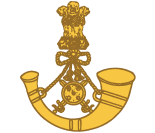Maratha Light Infantry
| Maratha Light Infantry | |
|---|---|

The Regimental Insignia of the Maratha Light Infantry
|
|
| Active | 1768-Present |
| Country |
|
| Branch | Indian Army |
| Type | Light Infantry |
| Role | Light Infantry |
| Nickname(s) | Ganpats |
| Motto(s) | Duty, Honour, Courage |
| March | Singarh |
| Anniversaries | 4 February (Regimental Day) |
| Decorations | 2 Victoria Crosses, 4 Ashoka Chakras, 10 Param Vishisht Seva Medal, 4 Maha Vir Chakras, 4 Kirti Chakras, 1 ACCL II, 14 Ati Vishisht Seva Medal, 34 Vir Chakras, 18 Shaurya Chakras, 4 ACCL III, 4 Yudh Seva Medal, 107 Sena Medals, 1 Shaurya Chakra & Bar, 23 Vishisht Seva Medal, 1 Padma Bhushan, 1 Arjuna award and 3 Unit Citations. |
| Battle honours | Naushera, Jhangar, Burki, Hussainiwala, Jamalpur, Burj, Suadih and Ruywa. |
| Commanders | |
| chief | Lt. General PJS Pannu |
The Marattha Light Infantry (MLI; also the Ganpats) is a regiment of the Indian Army. It was formed as the 103rd Mahrattas in 1768, making it the most senior light infantry regiment of the Army.
The class composition of the regiment was and is primarily formed by hardy, frugal and disciplined Maratha recruits from the former Maratha Empire. The men are mostly drawn from all over the state of Maharashtra, with some percentage from Marathi speaking areas of Karnataka including Coorg. Their regimental centre has been Belgaum, Karnataka, since 1922, which was part of the undivided Bombay state at that time. The battle cry of Maratha Light Infantry is, "Bol Shri Chhatrapati Shivaji Maharaj Ki Jai (Say Victory To King Shivaji)".
The Marathas were a potent force in 16th, 17th, and 18th century India. Their military qualities were brilliantly optimised in their historic campaigns against the Mughals and the English, under the leadership of the Emperor Chatrapati Shivaji Maharaj and succeeding Maratha rulers. Maratha armies, comprising both infantry and light cavalry, with the Maratha naval power had dominated the military scene in India for three centuries. The 1st Battalion of the Regiment, known as Jangi Paltan ("the fighting unit"), was raised in August 1768 as the 2nd Battalion Bombay Sepoys, to protect the British East India Company’s possessions on the islands of Bombay.
The second battalion known as Kali Panchwin followed the next year as the 3rd Battalion Bombay Sepoys. These two battalions were at the forefront of virtually every major engagement fought on the west coast from Surat to Cannanore during the last quarter of the 18th century. Prominent amongst these were the historic battles of Seedaseer and Seringapatam where in the words of Lord Wellesley their conduct and success were seldom equaled and never surpassed.
...
Wikipedia
